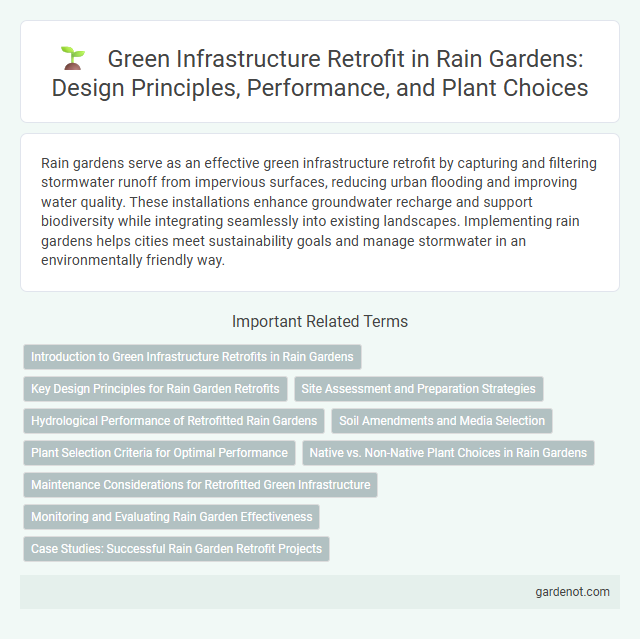Rain gardens serve as an effective green infrastructure retrofit by capturing and filtering stormwater runoff from impervious surfaces, reducing urban flooding and improving water quality. These installations enhance groundwater recharge and support biodiversity while integrating seamlessly into existing landscapes. Implementing rain gardens helps cities meet sustainability goals and manage stormwater in an environmentally friendly way.
Introduction to Green Infrastructure Retrofits in Rain Gardens
Green infrastructure retrofits in rain gardens enhance urban stormwater management by integrating natural water filtration systems into existing landscapes. These retrofits improve water quality, reduce runoff volume, and increase groundwater recharge through vegetation and soil amendments designed for optimal absorption. Implementing green infrastructure retrofits supports sustainable urban development while mitigating flooding and pollution in surrounding environments.
Key Design Principles for Rain Garden Retrofits
Rain garden retrofits emphasize infiltration, appropriate plant selection, and soil amendment to enhance stormwater management and reduce runoff volume. Key design principles include sizing the garden to accommodate contributing drainage area, ensuring adequate hydraulic residence time, and integrating native, deep-rooted vegetation for pollutant uptake and erosion control. Incorporating permeable soils and layering organic mulch improves water retention and supports microbial activity essential for nutrient cycling.
Site Assessment and Preparation Strategies
Conducting a thorough site assessment identifies existing drainage patterns, soil permeability, and potential contamination crucial for rain garden success. Preparation strategies include soil amendment to enhance infiltration rates and the removal of impervious surfaces to facilitate effective stormwater capture. Green infrastructure retrofit projects leverage these site-specific evaluations to maximize rain garden performance and urban water management.
Hydrological Performance of Retrofitted Rain Gardens
Retrofitted rain gardens significantly improve hydrological performance by enhancing stormwater infiltration and reducing surface runoff, promoting groundwater recharge and mitigating urban flooding. Studies show these green infrastructure retrofits increase peak flow attenuation and pollutant removal efficiency, optimizing watershed health. Incorporating native vegetation and engineered soil media further maximizes water retention capacity and nutrient uptake, ensuring sustainable stormwater management.
Soil Amendments and Media Selection
Soil amendments in green infrastructure retrofits enhance rain garden performance by improving infiltration rates, nutrient retention, and microbial activity. Selecting the appropriate media blend, often composed of sand, compost, and topsoil, ensures optimal water permeability and pollutant removal. Tailoring the soil mix to site-specific conditions maximizes stormwater management efficiency and supports healthy plant growth.
Plant Selection Criteria for Optimal Performance
Selecting appropriate native and adaptive plant species is crucial for rain garden success, ensuring efficient stormwater absorption and pollutant removal. Plants with deep root systems enhance soil permeability and stability, while diverse species support local biodiversity and resilience to varying moisture levels. Proper plant selection maximizes green infrastructure retrofit performance by improving water quality and reducing urban runoff.
Native vs. Non-Native Plant Choices in Rain Gardens
Selecting native plants for rain garden green infrastructure retrofits enhances local biodiversity, improves stormwater infiltration, and reduces maintenance compared to non-native species. Native plants possess deep root systems that stabilize soil and filter pollutants effectively, promoting healthier watershed ecosystems. Non-native plants may introduce invasive traits, jeopardizing ecological balance and leading to increased management costs in rain garden projects.
Maintenance Considerations for Retrofitted Green Infrastructure
Maintenance considerations for retrofitted green infrastructure, such as rain gardens, emphasize regular inspection to ensure optimal stormwater infiltration and pollutant removal. Proper upkeep includes debris removal, plant health monitoring, and sediment management to prevent clogging and maintain soil permeability. Effective maintenance supports long-term functionality and enhances urban resilience by improving water quality and reducing runoff.
Monitoring and Evaluating Rain Garden Effectiveness
Effective monitoring and evaluating rain garden performance involves tracking parameters such as runoff volume, pollutant load reduction, and soil moisture levels. Utilizing sensors and remote sensing technology enhances data accuracy for assessing green infrastructure retrofit outcomes. Long-term data collection supports adaptive management, ensuring rain garden effectiveness in urban stormwater control and water quality improvement.
Case Studies: Successful Rain Garden Retrofit Projects
Rain garden retrofit projects have demonstrated significant improvements in stormwater management by integrating green infrastructure into existing urban landscapes. Case studies in cities like Seattle and Philadelphia showcase how retrofitting underutilized spaces with rain gardens reduces runoff volume by up to 40%, enhances water quality through biofiltration, and supports local biodiversity. These successful implementations highlight cost-effective strategies for mitigating urban flooding while promoting sustainable water management practices.
Green infrastructure retrofit Infographic

 gardenot.com
gardenot.com